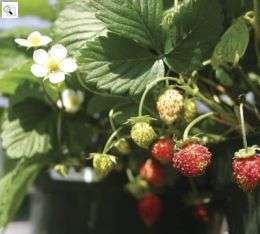Review article provides tools for the Rosaceae genomics community

A recent paper published in the journal Plant Physiology provides a comprehensive overview of the genomics tools and resources available for the rapidly growing Rosaceae scientific community. Rosaceae is an economically important group of plants that comprises more than 3,000 species, including strawberry, apple, peach and pear. Members of this plant family provide high-value nutritional foods and they are also the source of other desirable aesthetic and industrial products.
Modern breeding programs have produced numerous cultivars that play a significant role in commercial agricultural markets in the United States and around the world. In recent years, a global community of Rosaceae scientists has arisen that is benefiting from collaborative efforts designed to develop genetic and genomic resources for representative crops in this family such as apple, peach and strawberry.
These crops are emerging as attractive organisms for functional genomics studies due to the availability of resources like expressed sequence tags, bacterial artificial chromosome libraries, physical and genetic maps, molecular markers, genetic transformation protocols and bioinformatic tools.
In the past few years, for example, researchers at the Virginia Bioinformatics Institute and the Department of Horticulture in the College of Agriculture and Life Sciences at Virginia Tech have developed new procedures for the efficient transfer of specific DNA sequences into the genome of the woodland strawberry Fragaria vesca.
They have also developed tools for reverse and forward engineering genetics in this plant. Due to the small size of its genome, short reproductive cycle and small plant size, F. vesca is an ideal model system for genomic studies in commercial strawberry. Developments like high throughput transformation make the Rosaceae attractive as model systems for genomics research.
Vladimir Shulaev, associate professor at the Virginia Bioinformatics Institute and corresponding author of the article, remarked: "The review article has been compiled by some of the leading practitioners in Rosaceae genomics. It serves as a synopsis of the resources and initiatives of the Rosaceae community, covers recent developments in Rosaceae genomics, and summarizes plans to apply newly accumulated knowledge and resources toward breeding and crop improvement."
High throughput sequencing technologies, methods for quantitative gene expression analyses and novel phenotyping platforms are also under development. Researchers looking to study the crop species in the Rosaceae family are well positioned to benefit from these emerging technologies as well as the considerable genomics tools and resources already available for the Rosaceae community.
The paper, "Multiple models for Rosaceae genomics," appeared in the May 16, 2008 issue of Plant Physiology. For an abstract and list of authors, visit: www.plantphysiol.org/cgi/conte … ract/pp.107.115618v1
Source: Virginia Tech















